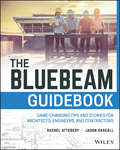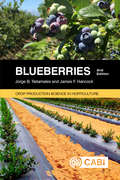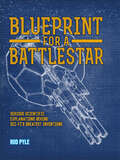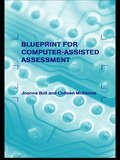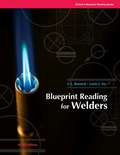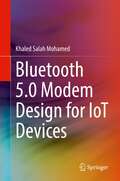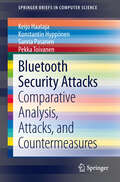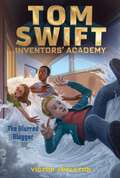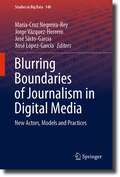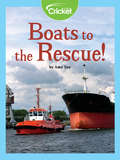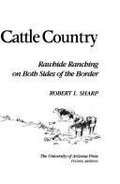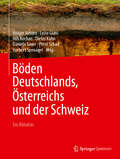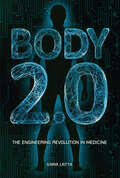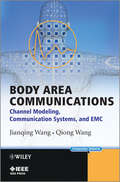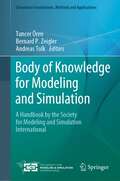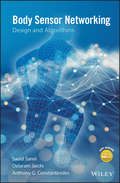- Table View
- List View
The Bluebeam Guidebook: Game-changing Tips and Stories for Architects, Engineers, and Contractors
by Rachel Attebery Jason HascallExpert tips for the last piece in the paperless puzzle The Bluebeam Guidebook offers comprehensive coverage of the industry’s leading PDF tool to help AEC professionals adopt a more efficient digital workflow. With desktop, mobile, and server-based products, Bluebeam makes collaboration and document coordination seamless, and provides a perfect complement to BIM software. This book shows you how to push the boundaries and discover the software’s true capabilities. Written expressly for working AEC professionals, this book offers tips, tricks, and ideas that cater to industry-specific needs. Expert instruction and step-by-step guidance helps you get started quickly, and case studies feature users from firms such as Kiewit, Populus, Sundt Construction, and more to show you how Bluebeam is quickly becoming a critical component of design and construction. Master the industry’s leading PDF software and alternative to Adobe Acrobat Create, edit, and markup documents in a way that suits the architecture and engineering workflow Learn how major AEC firms have transitioned seamlessly to digital workflows Integrate Bluebeam into estimating, quality control, field applications, and more The days of file boxes and paper reams are quickly coming to a close. The transition to paperless has been a boon for the AEC industry, in which collaboration and document sharing is central to getting the job done. BIM has revolutionized the design process, and Bluebeam offers that same level of functional innovation for the document side of every project. For AEC professionals seeking a better way to get things done, The Bluebeam Guidebook is your ultimate guide to everything Bluebeam can do for you.
Blueberries 2nd Edition (Crop Production Science In Horticulture)
by Jorge B. RetamalesThis new and updated edition covers major topics of interest to blueberry breeders and researchers: botany, physiology, nutrition, growth regulation, photosynthesis, environment, weeds, pests, diseases and postharvest management. The focus is on the highbush blueberry, though information on other blueberries and related species is also provided. <P><P>Blueberries are cultivated worldwide and this book explores plantings in a great diversity of environments, reflecting on the development of innovative cultural practices and conditions. It examines the increased scope and depth of research activities related to this crop and brings together the current status of knowledge on blueberry science and management. Explaining in an understandable manner the basic science behind the growth and development of blueberries, their botanical characteristics, as well as the implications and effects of various management practices and environmental conditions, the second edition of Blueberries also: <P><P> • Highlights emerging genetic information on the blueberry • Includes new information on pruning, grafting and irrigation • Covers current and potential uses of plant growth regulators • Gathers new information on fruit quality and consumer acceptance <P><P>Key Features: <P><P> • The definitive guide to blueberry cultivation for researchers, growers and breeders • Updated to reflect the latest developments in the industry • Comprehensive coverage of botanical, physiological and management of cultivated blueberries
Blueprint for a Battlestar: Serious Scientific Explanations Behind Sci-Fi's Greatest Inventions
by Rod Pyle“An enjoyable source of information on a wide variety of real or imagined technological marvels of the space age.” —National Space SocietyThis beautifully illustrated pop science book answers the enduring questions raised by science fiction, such as: Do hoverboards really exist, how can you bring a dinosaur back to life and can we really travel in time and space.Packed with stunning images, including seventy-five illustrations created exclusively for this book, Blueprint for a Battlestar takes twenty-five remarkable and memorable technologies from the world of sci-fi, from Star Wars and The Matrix to Ironman and The Terminator. Each concept will be explained and dissected to reveal the real science behind it. Some are boldly obvious—such as the Death Star and exoskeletons—and some less so (think bio-ports or cloaking devices). All are fascinating and will make wonderful explorations into the science of the future as we understand it today.“This is dream fuel for aspiring STEM students of all sorts. Blueprint for a Battlestar is a gateway drug for brainstorming that could change the world.” —Seattle Book Review“Will take readers on a fact-finding mission where the science is explained and the fiction just may become reality. Can it really work? For the sake of all those young engineers out there dreaming of a future filled with massive battlestars stretching far across the galaxy, we can only hope.” —Amazing Stories Magazine“A fun book that offers serious exploration of some of the technology that could be common place in the not too distant future.” —The Review Graveyard
A Blueprint for Computer-Assisted Assessment
by Joanna Bull Colleen McKennaThe rapid development and integration of computer-assisted assessment (CAA) in mainstream post-compulsory educational institutions today make this an exciting and invaluable reference text. It provides a practical, research-based guide on a subject that is becoming increasingly important as educational assessment changes and grows.The book addresses theory and practice, offering a comprehensive evaluation of many key aspects of CAA such as: * question and test design, scoring and analysis, and feedback and integration with other assessment methods* the role of CAA in feedback processes* wider use of technology to support and enhance assessment* technical, operational and support issues.The authors present a lucid,balanced analysis of the strengths and weaknesses of CAA. This text will appeal to all those involved in higher or further education who wish to model their CAA systems on the best practice available.
Blueprint Reading for Plumbers in Residential & Commercial (Blueprint Reading Series)
by Bartholomew D'Arcangelo Benedict D'Arcangelo J. Russell GuestBlueprint Reading For Plumbers provides instructional material for plumbing and pipe fitting students who must develop the ability to interpret trade blueprints and to plan the installation of the required plumbing. This is accompanied by reference to the Building Officials and Code Administrators (BOCA) plumbing code for pipe size and material as well as acceptable fittings and fixtures. This revision brings the study up to date in code, pipe and fitting materials, and in fixture designs.
Blueprint Reading for Welders: Instructor's Guide
by A. E. Bennett Louis J. SiyNIMAC-sourced textbook
Bluetooth 5.0 Modem Design for IoT Devices
by Khaled Salah MohamedThis book provides an introduction to Bluetooth technology, with a specific focus on developing a hardware architecture for its modem. The major concepts and techniques involved in Bluetooth technology are discussed, with special emphasis on hardware mapping. The book starts simply to allow the reader to master quickly the basic concepts, before addressing the advanced features. This book differs from existing content in that it presents Bluetooth Transceiver architecture suitable for implementation in an FPGA for IoT Devices. It will examine several digital algorithms for modulation and demodulation of Bluetooth signals, locking on the carrier phase, and synchronizing the symbol. Many of these previously analog designs have been translated to the digital domain.
Bluetooth Essentials for Programmers
by Albert S. Huang Larry RudolphThis book provides an introduction to Bluetooth programming, with a specific focus on developing real code. The authors discuss the major concepts and techniques involved in Bluetooth programming, with special emphasis on how they relate to other networking technologies. They provide specific descriptions and examples for creating applications in a number of programming languages and environments including Python, C, Java, GNU/Linux, Windows XP, Symbian Series 60, and Mac OS X. No previous experience with Bluetooth is assumed, and the material is suitable for anyone with some programming background. The authors place special emphasis on the essential concepts and techniques of Bluetooth programming, starting simply and allowing the reader to quickly master the basic concepts before addressing advanced features.
Bluetooth Security Attacks: Comparative Analysis, Attacks, and Countermeasures (SpringerBriefs in Computer Science)
by Keijo Haataja Konstantin Hyppönen Sanna Pasanen Pekka ToivanenBluetooth technology has enjoyed tremendous success, and it's now employed in billions of devices for short-range wireless data and real-time audio or video transfer. In this book the authors provide an overview of Bluetooth security. They examine network vulnerabilities and provide a literature-review comparative analysis of recent security attacks. They analyze and explain related countermeasures, including one based on secure simple pairing, and they also propose a novel attack that works against all existing Bluetooth versions. They conclude with a discussion on future research directions. The book is appropriate for practitioners and researchers in information security, in particular those engaged in the design of networked and mobile devices.
The Blurred Blogger (Tom Swift Inventors' Academy #7)
by Victor AppletonTom and his friends track down a mysterious blogger who pushes pranks too far in this seventh novel in Tom Swift Inventors&’ Academy—perfect for fans of The Hardy Boys or Alex Rider series.A series of videos called &“The Not-so-Swift Academy&” are the talk of Tom Swift&’s tech-focused school. A mysterious host whose face is blurred shows hidden camera footage of different students being pranked—from a rubber tarantula leaping out of one of the terrariums to water flash freezing. Tom and his classmates are on edge, wondering which unlucky student will be the star of the next episode. They&’re on the lookout for hidden cameras and searching for signs of the next prank around every corner and behind every locker door. Tired of the tension, Sam decides to take matters in her own hands. She&’s going to bust the blogger by studying the videos for clues. But as Sam pieces the clues together, she unveils the biggest prank of all—someone&’s trying to frame her for the videos! Can Tom and his friends unmask the blurred blogger and clear Sam&’s name before they become the targets of the prankster&’s increasingly nefarious stunts?
Blurring Boundaries of Journalism in Digital Media: New Actors, Models and Practices (Studies in Big Data #140)
by María-Cruz Negreira-Rey Jorge Vázquez-Herrero José Sixto-García Xosé López-GarcíaWhat changes have affected the definition of the boundaries of journalism in the last decade? How do technologies influence the boundaries of journalism? Are threats and opportunities identified in those blurred areas of journalism? The aim of this book is to answer these questions and to address, from different perspectives, the redefinition of the boundaries of journalism according to the most recent changes in digital media concerning actors, models, and practices.More than 40 authors from eleven countries contribute to this book, which is structured into six sections to analyze the principles of journalism today, sustainability strategies in the digital context, old and new actors, formats and narratives, adaptation to the mobile scenario and to social platforms, and the changes introduced by artificial intelligence. Undoubtedly, this book is of interest to both academics and professionals, as well as a crucial reference for scholars and students of media and journalism.Chapter 7 is available open access under a Creative Commons Attribution 4.0 International License via link.springer.com.
Blushing Blake
by Michele L. RichBlake has an embarrassing experience presenting during a science presentation to his class. He cleverly uses that situation as the starting point for a new experiment.
The Boat Alphabet Book (Jerry Pallotta's Alphabet Books)
by Jerry PallottaAhoy, mateys! Get on board! Boats and the need for them have been around for thousands of years. Reed boats might have been the first boat ever to be built. The Vikings built wooden ships that were strong and ornate. And now boats like an Aircraft Carrier house 6,000 people and can carry over 100 planes. In Jerry Pallotta's newest book we get to see an entire alphabet of floating wonders. David Biedrzycki has provided dramatic settings for a variety of boats and captures the mood of each body of water. In one he paints a calm lake where a red canoe glides across the water and in another the stormy swells of an angry ocean tossing a three-masted Xebec. The facts about each boat are sprinkled with traditional Pallotta humor.
Boats! (Fountas & Pinnell Classroom, Guided Reading)
by Amy TichbourneNIMAC-sourced textbook. In a Boat. How fast can you go in a boat?
Boats to the Rescue!
by Amy TaoSafety is important, no matter the location, whether on land or on sea! Children can explore the many boats that are used on the ocean. Tugboats, police boats, ice breaker boats, and rescue boats, all have a different purpose for helping people be safe or to provide rescue on the sea.
Bob Sharp's Cattle Country: Rawhide Ranching on Both Sides of the Border
by Robert L. SharpA memoir about the life of a cattle rancher in the 1920s.
Bob's Busy Screwdriver (Bob the Builder)
by Keith ChapmanCan we fix it? Yes, we can! With four sturdy tool-shaped board books -- a hammer, saw, screwdriver, and wrench, little helpers will have fun building along with Bob!
Böden Deutschlands, Österreichs und der Schweiz: Ein Bildatlas
by Peter Schad Holger Joisten Luise Giani Nils Kochan Dieter Kühn Daniela Sauer Herbert SponagelBöden sind eine Lebensgrundlage der Menschheit. Sie kennenzulernen ist nicht nur wichtig, sondern auch außerordentlich faszinierend. Dieser Bildatlas zeigt die Vielfalt unserer Böden, erklärt ihre Entstehung, ihre Eigenschaften, ihre Gefährdung und wie wir sie schützen können.200 Bodenprofile werden mit charakteristischen Boden- und Landschaftsbildern vorgestellt, mit detaillierten Beschreibungen erläutert und durch Analysendaten ergänzt. Jedes Profil wird nach der Bodenkundlichen Kartieranleitung (KA5) boden- und substratsystematisch eingeordnet. Auch werden die Bezeichnungen dieser Böden nach der internationalen „World Reference Base for Soil Resources“ (WRB) angegeben. Zahlreiche Karten zeigen die Verbreitung von Bodenregionen und Bodenklassen. Darstellungen der Abfolge der Böden in der Landschaft (Catenen) ordnen die Böden in ihre Umgebung ein. Zum besseren Verständnis sind wichtige bodenkundliche Sachverhalte in Einführungskapiteln anschaulich erklärt.Dieses Buch ist das Werk von 44 Autorinnen und Autoren sowie sieben Herausgebern, die ihr umfangreiches Experten- und Regionalwissen eingebracht haben. Es richtet sich sowohl an ein Fachpublikum, an Lernende und Lehrende, als auch an diejenigen, die sich bisher nicht mit Böden beschäftigt haben, die jedoch an der Vielfalt unserer Böden, ihrer Schönheit und ihrem landschaftsbezogenen Vorkommen interessiert sind.
Body 2.0: The Engineering Revolution in Medicine
by Sara LattaScientists are on the verge of a revolution in biomedical engineering that will forever change the way we think about medicine, even life itself. Cutting-edge researchers are working to build body organs and tissue in the lab. They are developing ways to encourage the body to regenerate damaged or diseased bone and muscle tissue. Scientists are striving to re-route visual stimuli to the brain to help blind people see. They may soon discover methods to enlist the trillions of microbes living in our bodies to help us fight disease. Learn about four strands of bioengineering—tissue engineering and regenerative medicine, neuroengineering, microbial science, and genetic engineering and synthetic biology—and meet scientists working in these fields.
Body Area Communications: Channel Modeling, Communication Systems, and EMC (Wiley - IEEE)
by Jianqing Wang Qiong WangProviding an introduction to the fundamentals of body area communications, this book covers the key topics of channel modeling, modulation and demodulation, and performance evaluation A systematic introduction to body area networks (BAN), this book focuses on three major parts: channel modeling, modulation/demodulation communications performance, and electromagnetic compatibility considerations. The content is logically structured to lead readers from an introductory level through to in-depth and more advanced topics. Provides a concise introduction to this emerging topic based on classroom-tested materials Details the latest IEEE 802.15.6 standard activities Moves from very basic physics, to useful mathematic models, and then to practical considerations Covers not only EM physics and communications, but also biological applications Topics approached include: link budget, bit error rate performance, RAKE and diversity reception; SAR analysis for human safety evaluation; and modeling of electromagnetic interference to implanted cardiac pacemakers Provides Matlab and Fortran programs for download from the Companion Website
Body Area Network Challenges and Solutions (EAI/Springer Innovations in Communication and Computing)
by R. Maheswar G. R. Kanagachidambaresan R. Jayaparvathy Sabu M. ThampiThis book provides a novel solution for existing challenges in wireless body sensor networks (WBAN) such as network lifetime, fault tolerant approaches, reliability, security, and privacy. The contributors first discuss emerging trends of WBAN in the present health care system. They then provide possible solutions to challenges inherent in WBANs. Finally, they discuss results in working environments. Topics include communication protocols of implanted, wearable and nano body sensor networks; energy harvesting methodologies and experimentation for WBAN; reliability analysis and fault tolerant architecture for WBAN; and handling network failure during critical duration. The contributors consist of researchers and practitioners in WBAN around the world.
Body Area Networks
by Sandeep Kumar Shrinath Gupta Tridib Mukherjee Krishna Kumar VenkatasubramanianBody area networks (BANs) are networks of wireless sensors and medical devices embedded in clothing, worn on or implanted in the body, and have the potential to revolutionize healthcare by enabling pervasive healthcare. However, due to their critical applications affecting human health, challenges arise when designing them to ensure they are safe for the user, sustainable without requiring frequent battery replacements and secure from interference and malicious attacks. This book lays the foundations of how BANs can be redesigned from a cyber-physical systems perspective (CPS) to overcome these issues. Introducing cutting-edge theoretical and practical techniques and taking into account the unique environment-coupled characteristics of BANs, the book examines how we can re-imagine the design of safe, secure and sustainable BANs. It features real-world case studies, suggestions for further investigation and project ideas, making it invaluable for anyone involved in pervasive and mobile healthcare, telemedicine, medical apps and other cyber-physical systems.
Body of Knowledge: A Dark Tale Based on True Events in Dublin, Ireland
by Jennifer MasonTake a daunting journey into the "dissection theater." This fictional story will give you chills and thrills while presenting you with a plausible moral dilemma.
Body of Knowledge for Modeling and Simulation: A Handbook by the Society for Modeling and Simulation International (Simulation Foundations, Methods and Applications)
by Tuncer Ören Bernard P. Zeigler Andreas TolkCommissioned by the Society for Modeling and Simulation International (SCS), this needed, useful new ‘Body of Knowledge’ (BoK) collects and organizes the common understanding of a wide collection of professionals and professional associations.Modeling and simulation (M&S) is a ubiquitous discipline that lays the computational foundation for real and virtual experimentation, clearly stating boundaries—and interactions—of systems, data, and representations. The field is well known, too, for its training support via simulations and simulators. Indeed, with computers increasingly influencing the activities of today’s world, M&S is the third pillar of scientific understanding, taking its place along with theory building and empirical observation.This valuable new handbook provides intellectual support for all disciplines in analysis, design and optimization. It contributes increasingly to the growing number of computational disciplines, addressing the broad variety of contributing as well as supported disciplines and application domains. Further, each of its sections provide numerous references for further information. Highly comprehensive, the BoK represents many viewpoints and facets, captured under such topics as:Mathematical and Systems Theory FoundationsSimulation Formalisms and ParadigmsSynergies with Systems Engineering and Artificial IntelligenceMultidisciplinary ChallengesEthics and PhilosophyHistorical PerspectivesExamining theoretical as well as practical challenges, this unique volume addresses the many facets of M&S for scholars, students, and practitioners. As such, it affords readers from all science, engineering, and arts disciplines a comprehensive and concise representation of concepts, terms, and activities needed to explain the M&S discipline.Tuncer Ören is Professor Emeritus at the University of Ottawa. Bernard Zeigler is Professor Emeritus at the University of Arizona. Andreas Tolk is Chief Scientist at The MITRE Corporation. All three editors are long-time members and Fellows of the Society for Modeling and Simulation International. Under the leadership of three SCS Fellows, Dr. Ören, University of Ottawa, Dr. Zeigler, The University of Arizona, and Dr. Tolk, The MITRE Corporation, more than 50 international scholars from 15 countries provided insights and experience to compile this initial M&S Body of Knowledge.
Body Sensor Networking, Design and Algorithms
by Saeid Sanei Delaram Jarchi Anthony G. ConstantinidesA complete guide to the state of the art theoretical and manufacturing developments of body sensor network, design, and algorithms In Body Sensor Networking, Design, and Algorithms, professionals in the field of Biomedical Engineering and e-health get an in-depth look at advancements, changes, and developments. When it comes to advances in the industry, the text looks at cooperative networks, noninvasive and implantable sensor microelectronics, wireless sensor networks, platforms, and optimization—to name a few. Each chapter provides essential information needed to understand the current landscape of technology and mechanical developments. It covers subjects including Physiological Sensors, Sleep Stage Classification, Contactless Monitoring, and much more. Among the many topics covered, the text also includes additions such as: ● Over 120 figures, charts, and tables to assist with the understanding of complex topics ● Design examples and detailed experimental works ● A companion website featuring MATLAB and selected data sets Additionally, readers will learn about wearable and implantable devices, invasive and noninvasive monitoring, biocompatibility, and the tools and platforms for long-term, low-power deployment of wireless communications. It’s an essential resource for understanding the applications and practical implementation of BSN when it comes to elderly care, how to manage patients with chronic illnesses and diseases, and use cases for rehabilitation.
